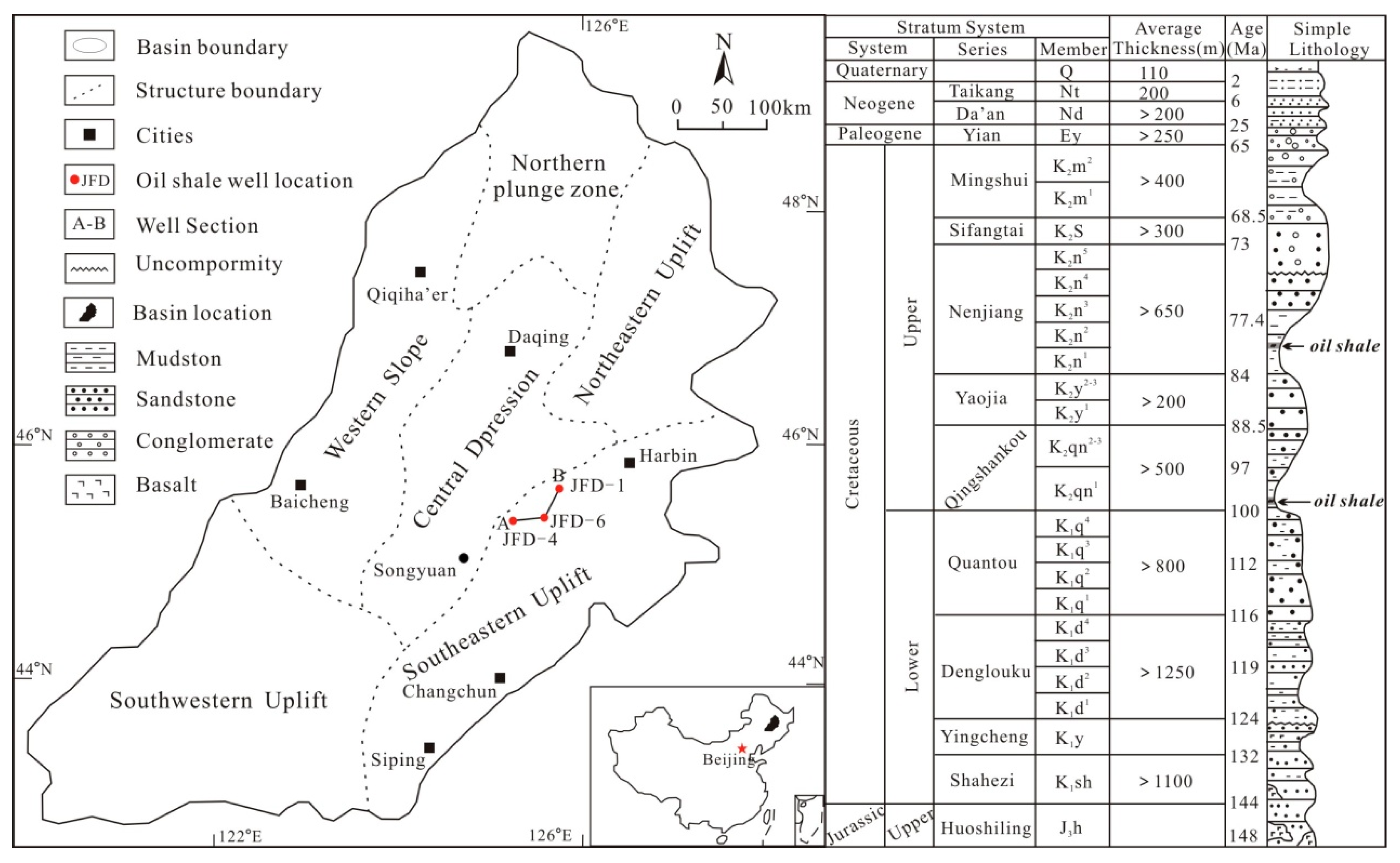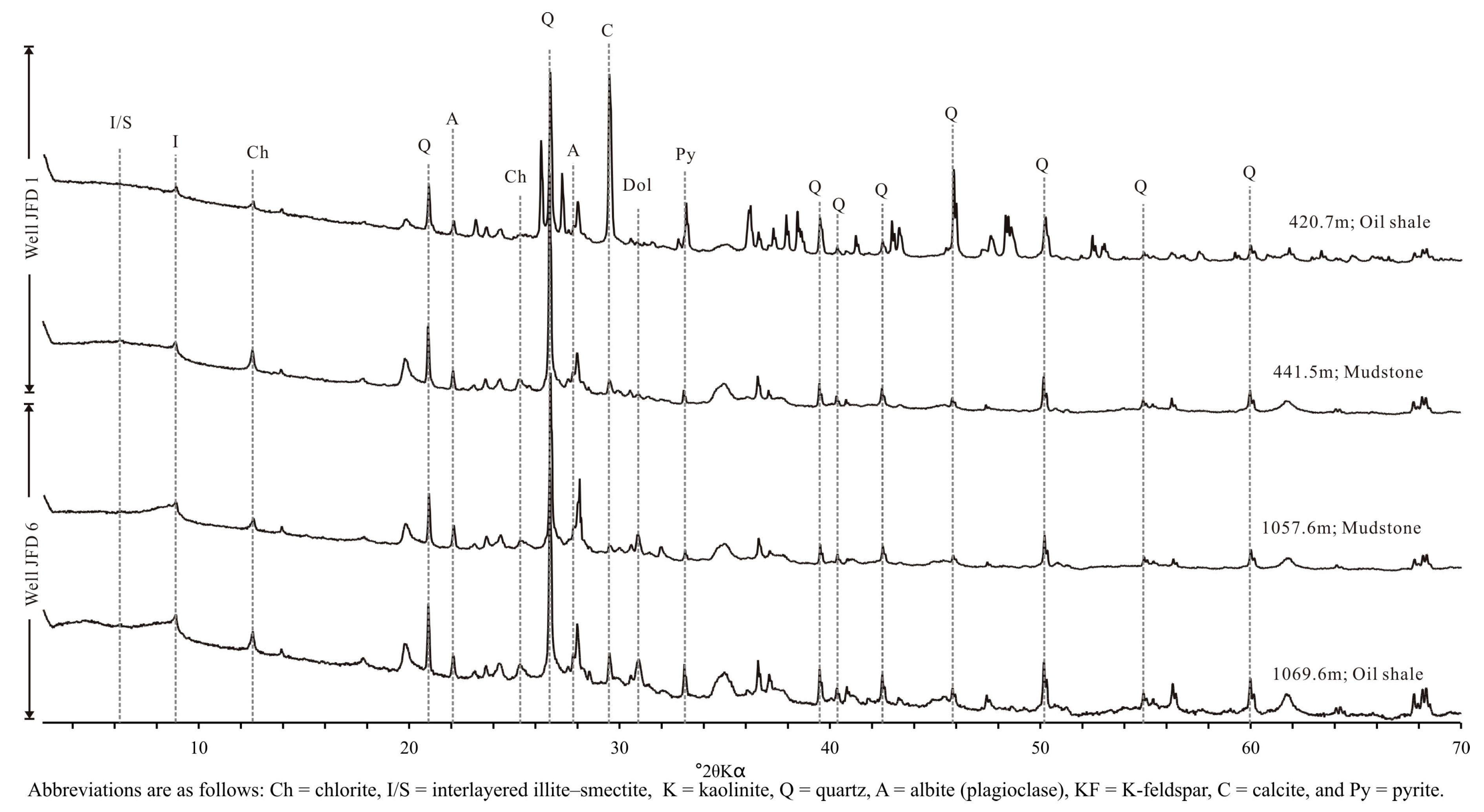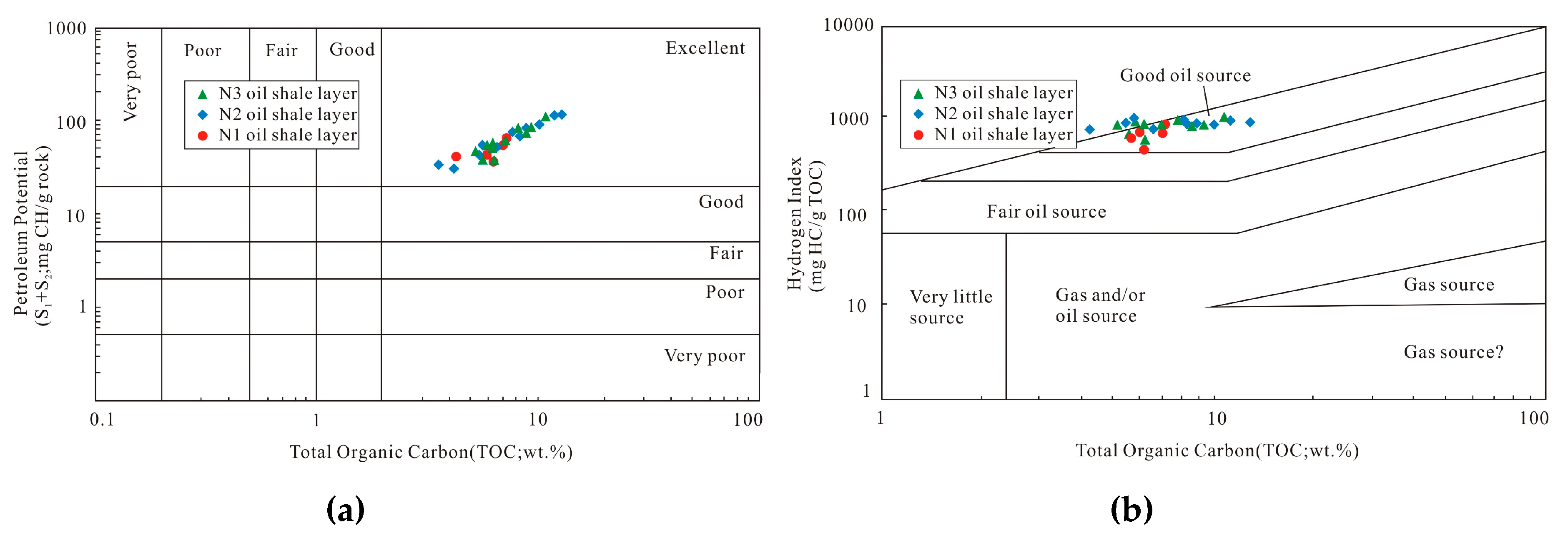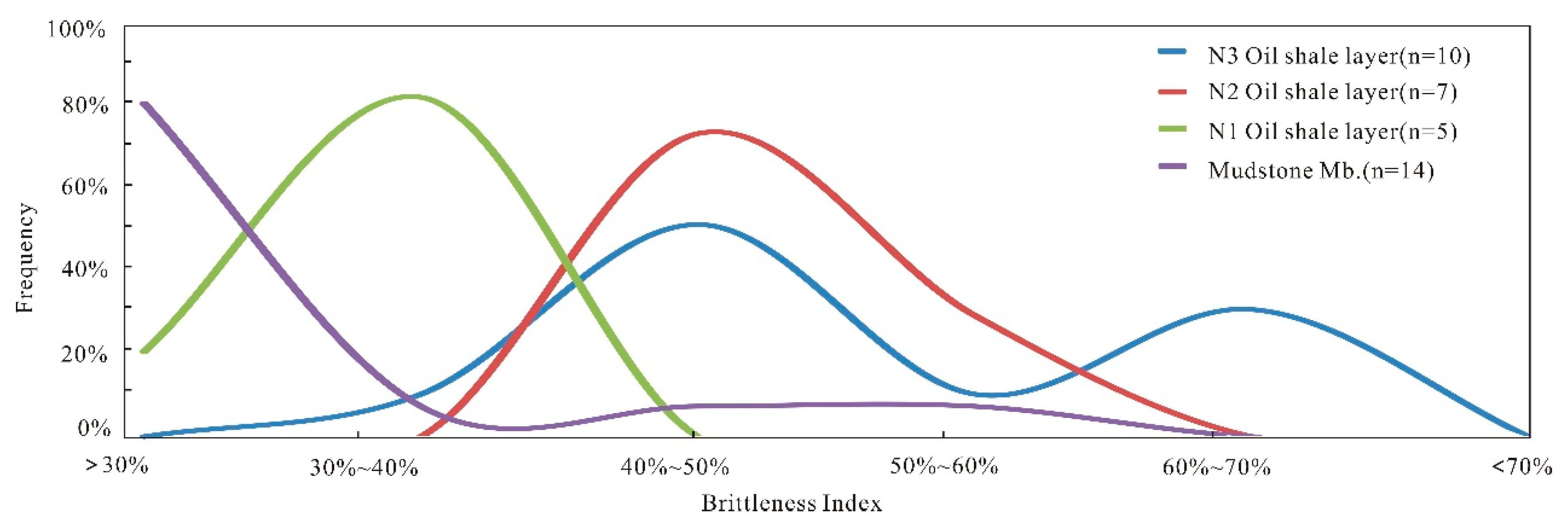Sequence Stratigraphy and Geochemistry of Oil Shale Deposits in the Upper Cretaceous Qingshankou Formation of the Songliao Basin, NE China: Implications for the Geological Optimization of In Situ Oil Shale Conversion Processing
Abstract
:1. Introduction
2. Geological Setting
3. Samples and Methods
3.1. Materials and Sampling Location
3.2. Spectral Trend Attribute Analysis and Sequence Stratigraphic Division
3.3. X-Ray Diffraction Analysis
3.4. Organic Geochemical Analysis
3.5. Organic Petrography
4. Results
4.1. Lithostratigraphy of K2qn1
4.2. Whole-Rock Powder Analysis
4.3. Clay Mineralogy (<2 μm Fraction)
4.4. Bulk Geochemical Data
4.5. Sequence Stratigraphic Features of the K2qn1 Member
5. Discussion
5.1. Origin of Organic Matter and Bioproductivity
5.2. Effects of Mineral Dilution on Organic Matter Abundances
5.3. Thermal Evolution of Organic Matter
5.4. Hydrocarbon Generation Potential
5.5. Rock Brittleness
5.6. Geological Optimization of ICP
6. Conclusions
Author Contributions
Funding
Conflicts of Interest
References
- Zhao, W.Z.; Hu, S.Y.; Hou, L.H. Connotation and strategic role of in-situ conversion processing of shale oil underground in the onshore China. Pet. Explor. Dev. 2018, 45, 563–572. [Google Scholar] [CrossRef]
- Liu, Z.J.; Meng, Q.T.; Dong, Q.S.; Zhu, J.W.; Ye, S.Q.; Liu, R.; Jia, J.L. Characteristics and resource potential of oil shale in China. Oil Shale 2017, 34, 15–41. [Google Scholar] [CrossRef] [Green Version]
- Liu, Z.J.; Yang, H.L.; Dong, Q.S.; Zhu, J.W.; Guo, W. Oil Shale in China; Petroleum Industry Press: Beijing, China, 2009; pp. 14–115. [Google Scholar]
- He, W.; Sun, Y.; Guo, W.; Shan, X.; Su, S.; Zheng, S.; Deng, S.; Kang, S.; Zhang, X. Organic Geochemical Characteristics of the Upper Cretaceous Qingshankou Formation Oil Shales in the Fuyu Oilfield, Songliao Basin, China: Implications for Oil-Generation Potential and Depositional Environment. Energies 2019, 12, 4778. [Google Scholar] [CrossRef] [Green Version]
- Xue, H.Q.; Li, S.Y.; Wang, H.T. Pyrolysis kinetics of oil shale from northern Songliao Basin in China. Oil Shale 2010, 27, 5–16. [Google Scholar]
- Zou, C.N.; Yang, Z.; Cui, J.W. Formation mechanism, geological characteristics and development strategy of nonmarine shale oil in China. Pet. Explor. Dev. 2013, 40, 14–26. [Google Scholar] [CrossRef]
- Jarvie, D.M. Shale resource systems for oil and gas: Part 2: Shale-oil resource systems. In Shale Reservoirs: Giant Resources for the 21st Century; Breyer, J.A., Ed.; AAPG: Tulsa, OK, USA, 2012; pp. 89–119. [Google Scholar]
- Cander, H. What is Unconventional Resources; AAPG Annual Convention and Exhibition: Long Beach, CA, USA, 2012. [Google Scholar]
- Liu, J.D.; Wang, J.; Wang, Y.B.; Feng, M.S.; Liu, H. Sequence-lithology Palaeogeography charateristic of cretaceous in northern Kashi Area of Tarim Basin. Earth Sci. Environ. 2013, 35, 1–14. [Google Scholar]
- Tang, W.; Wang, Y.M.; Yuan, W.F.; Sun, X.J.; Zheng, G.C.; Zhong, M.H. Sequence stratigraphic characteristics and favourable hydrocarbon accumulation prediction of Triassic in Sangtamu Area. Xi’an Shiyou Univ. Nat. Sci. Ed. 2013, 28, 1–10. [Google Scholar]
- Zhang, H.Z. The Rescarch of Applications of Spectral Analysis Technique of Wireline Logs in the Siliciclastic Sequence Stratigraphy Analyse; China Ocean University: Qingdao, China, 2005. [Google Scholar]
- Liu, B.; Wang, H.; Fu, X.; Bai, Y.; Bai, L.; Jia, M.; He, B. Lithofacies and depositional setting of a highly prospective lacustrine shale oil succession from the Upper Cretaceous Qingshankou Formation in the Gulong Sag, northern Songliao Basin, Northeast China. AAPG Bull. 2019, 103, 405–432. [Google Scholar] [CrossRef] [Green Version]
- Hu, W.S.; Lv, B.W.; Zhang, W.J.; Mao, Z.G.; Leng, J.; Guan, D.Y. Evolution and dynamics of the Songliao basin. Chin. J. Geol. 2005, 40, 16–31. [Google Scholar]
- Feng, Z.Q.; Jia, C.Z.; Xie, X.N.; Zhang, S.; Feng, Z.H. Tectonostratigraphic units andstratigraphic sequences of the nonmarine Songliao basin, Northeast China. Basin Res. 2010, 22, 79–95. [Google Scholar]
- Jia, J.L.; Bechtel, A.; Liu, Z.J.; Susanne, A.I.S.; Sun, P.C.; Sachsenhofer, R.F. Oil shalefor-mation in the Upper Cretaceous Nenjiang Formation of the Songliao Basin (NE China), implications from organic and inorganic geochemical analyses. Int. J. Coal Geol. 2013, 113, 11–26. [Google Scholar] [CrossRef]
- Nio, S.D.; Brouwer, J.; Smith, D.; Jonh, M.; Bhm, A. Spectral trend attribute analysis: Applications in the stratigraphic analysis of wireline logs. First Break 2005, 23, 71e5. [Google Scholar]
- Zhang, H.Z. Carbonate Stratigraphic Correlation and Favourable Reservoir Prediction of Ordovician in Tahe District IV; China University of Geosciences: Beijing, China, 2011. [Google Scholar]
- Lu, S.X.; Zhang, H.Z.; Meng, E.; Sun, X.G. Application of INPEFA technique to carry out sequence-stratigraphic study. Oil Geophys. Prospect. 2007, 42, 703e8. [Google Scholar]
- Brindley, G.W.; Brown, G. Crystal structure of Clay Minerals and Their X-ray Identification; Mineralogical Society: London, UK, 1980; p. 495. [Google Scholar]
- Moore, D.M.; Reynolds, R.C., Jr. X-Ray Diffraction and the Identification and Analysis of Clay Minerals, 2nd ed.; Oxford University Press: New York, NY, USA, 1997. [Google Scholar]
- Peters, K.E.; Cassa, M.R. Applied source rock geochemistry. In the Petroleum System—From Source to Trap. Am. Assoc. Pet. Geol. Mem. 1994, 60, 93–120. [Google Scholar]
- Achim, B.; Jia, J.L. Palaeoenvironmental conditions during deposition of the Upper Cretaceous oilshale sequences in the Songliao Basin (NE China): Implications from geochemical analysis. Org. Geochem. 2012, 46, 76–95. [Google Scholar]
- Espitalié, J.; Marquis, F.; Barsony, I. Geochemical logging. In Analytical Pyrolysis; Voorhess, K.J., Ed.; Butterworths: Boston, MA, USA, 1984; pp. 53–79. [Google Scholar]
- Langford, F.F.; Blanc-Valleron, M.M. Interpreting Rock–Eval pyrolysis data using graphs of pyrolyzable hydrocarbons vs. total organic carbon. Am. Assoc. Pet. Geol. Bull. 1990, 74, 799–804. [Google Scholar]
- Zhang, M.M. Establishment of the Organic Matter Aggregation Models in the oil Shale Bearing Series of Permian Lucaogou Formation in the Northern Bogda Mountain Based on Biogeochemistry; Jilin University: Changchun, China, 2016; pp. 1–60, (In Chinese with English abstract). [Google Scholar]
- Wu, L.X.; Gu, X.Z.; Sheng, Z.W. Fast Quantitative Evaluation Method for Source Rock on Rock-Eval Analysis; Science Press: Beijing, China, 1986; pp. 39–47. (In Chinese) [Google Scholar]
- Song, Y.; Liu, Z.; Meng, Q.; Xu, J.; Sun, P.; Cheng, L.; Zheng, G. Multiple controlling factors of the enrichment of organic matter in the Upper Cretaceous oil shale sequences of the Songliao Basin, NE China: Implications from geochemical analyses. Oil Shale 2016, 33, 142–166. [Google Scholar] [CrossRef]
- Keller, G.; Pardo, A. Age and paleoenvironment of the Cenomanian-Turonian global stratotype section and point at Pueblo, Colorado. Mar. Micropaleontol. 2004, 51, 95–128. [Google Scholar] [CrossRef]
- Westermann, S.; Caron, M.; Fiet, N.; Fleitmann, D.; Matera, V.; Adatte, T.; Föllmi, K.B. Evidence for oxic conditions during oceanic anoxic event in the northern Tethyan pelagic realm. Cretac. Res. 2010, 31, 500–514. [Google Scholar] [CrossRef] [Green Version]
- Stein, M.; Föllmi, K.B.; Westermann, S.; Godet, A.; Adatte, T.; Matera, V.; Fleitmann, D.; Berner, Z. Progressive palaeoenvironmental change during the Late Barremian-Early Aptian as prelude to Oceanic Anoxic Event 1a: Evidence from the Gorgo a Cerbara section (Umbria-Marche basin, central Italy). Palaeogeogr. Palaeoclimatol. Palaeoecol. 2011, 302, 396–406. [Google Scholar] [CrossRef]
- Bomou, B.; Adatte, T.; Tantawy, A.A.; Mort, H.; Fleitmann, D.; Huang, Y.; Föllmi, K.B. The expression of the Cenomanian-Turonian oceanic anoxic event in Tibet. Palaeogeogr. Palaeoclimatol. Palaeoecol. 2013, 369, 466–481. [Google Scholar] [CrossRef]
- Montero-Serrano, J.C.; Föllmi, K.B.; Adatte, T.; Spangenberg, J.E.; Tribovillard, N.; Fantasia, A.; Suan, G. Continental weathering and redox conditions during the early Toarcian oceanic anoxicevent in the northwestern Tethys: Insight from the Posidonia shale section in the Swiss Jura Mountains. Palaeogeogr. Palaeoclimatol. Palaeoecol. 2015, 429, 83–99. [Google Scholar] [CrossRef] [Green Version]
- Einsele, G.; Hinderer, M. Quantifying denudation and sediment–accumulation systems (open and closed lakes): Basic concepts and first results. Palaeogeogr. Palaeoclimatol. Palaeoecol. 1998, 140, 7–21. [Google Scholar] [CrossRef]
- Smith, M.E.; Carroll, A.R.; Scott, J.J.; Singer, B.S. Early Eocene carbon isotope excursions and landscape destabilization at eccentricity minima: Green River Formation of Wyoming. Earth Planet. Sci. Lett. 2014, 403, 393–406. [Google Scholar] [CrossRef]
- Hao, F.; Zhou, X.; Zhu, Y.; Yang, Y. Lacustrine source rock deposition in response to co-evolution of environments and organisms controlled by tectonic subsidence and climate, Bohai Bay Basin, China. Org. Geochem. 2011, 42, 323–339. [Google Scholar] [CrossRef]
- Peters, K.E. Guidelines for evaluating petroleum source rocks using programmed pyrolysis. AAPG Bull. 1986, 70, 318–329. [Google Scholar]
- Demaison, G.; Huizinga, B.J. Genetic classification of petroleum systems using three factors: Charge, migration, and entrapment. In The Petroleum Systeme From Source to Trap, AAPG Memoir; Magoon, L.B., Dow, W.G., Eds.; American Association of Petroleum Geologists: Tulsa, OK, USA, 1994; Volume 60, pp. 3–24. [Google Scholar]
- Xu, J.J.; Liu, Z.J. Basin evolution and oil shale deposition during Upper Cretaceous in the Songliao Basin (NE China): Implications from sequence stratigraphy and geochemistry. Int. J. Coal Geol. 2015, 149, 9–23. [Google Scholar] [CrossRef]
- Huo, Z.P.; Zhang, J.C. An improved evaluation method for the brittleness index of shale and its application—A case study from the southern north China basin. J. Nat. Gas Sci. Eng. 2018, 59, 47–55. [Google Scholar] [CrossRef]
- Wang, X.D.; Wang, Y.H.; Wang, T.T.; You, Y.; Wang, C.Y. Calculation of sandstone brittleness index by mineral content—A case study of tight sandstone reservoir in chang 6 member of heshui area, ordos basin. J. Chengdu Univ. Technol. 2008, 45, 367–373, (In Chinese with English abstract). [Google Scholar] [CrossRef]
- Sun, Y.H.; Bai, F.T.; Lu, X.H. A Nover Energy-Efficient Pyrolysis Process: Self-pyrolysis of oil shale triggered by Topo-chemical Heat in a Horizontal Fixed bed. Sci. Rep. 2015, 5, 82–90. [Google Scholar]
- Zhao, J.M. Device for Extracting Shale Oil and Gas by Fracturing Chemical Distillation of Oil Shale in Situ Horizontal Well. USA Patent Application Publication Cn203499663u, 26 March 2014. (In Chinese). [Google Scholar]

















| Depth(m) | Sample | Lithology | Well | Oil Shale Layer | S1 | S2 | Tmax | S1/(S1 + S2) | HCI | HI | TS | TOC | VR |
|---|---|---|---|---|---|---|---|---|---|---|---|---|---|
| mg/g | mg/g | °C | mg/g TOC | mg/g TOC | wt.% | wt.% | %Ro | ||||||
| 420.70 | B1-97 | oil shale | JFD-1 | N3 | 1.86 | 80.03 | 446.00 | 0.02 | 20.31 | 873.69 | 0.93 | 9.16 | |
| 421.23 | B1-99 | oil shale | JFD-1 | N3 | 0.52 | 39.41 | 442.00 | 0.01 | 9.51 | 720.48 | 0.62 | 5.47 | 0.48 |
| 423.34 | B1-95 | oil shale | JFD-1 | N3 | 0.41 | 37.95 | 442.00 | 0.01 | 6.62 | 613.09 | 0.57 | 6.19 | |
| 429.40 | B1-98 | oil shale | JFD-1 | N3 | 0.53 | 37.81 | 442.00 | 0.01 | 15.14 | 1080.29 | 0.52 | 3.50 | 0.5 |
| 432.80 | B1-91 | oil shale | JFD-1 | N2 | 1.24 | 54.67 | 438.00 | 0.02 | 18.70 | 824.59 | 0.76 | 6.63 | |
| 433.93 | JFD1-B1 | oil shale | JFD-1 | N2 | 1.45 | 56.89 | 435.00 | 0.02 | 25.80 | 1012.28 | 0.61 | 5.62 | 0.48 |
| 434.33 | JFD1-B2 | oil shale | JFD-1 | N2 | 2.95 | 94.97 | 436.00 | 0.03 | 28.92 | 931.08 | 1.08 | 10.20 | |
| 434.53 | JFD1-139 | oil shale | JFD-1 | N2 | 1.96 | 74.21 | 438.00 | 0.03 | 24.02 | 909.44 | 0.46 | 8.16 | |
| 435.70 | B1-88 | oil shale | JFD-1 | N2 | 0.44 | 33.13 | 441.00 | 0.01 | 10.40 | 783.22 | 0.34 | 4.23 | |
| 442.63 | JFD1-186 | oil shale | JFD-1 | N1 | 0.65 | 55.55 | 444.00 | 0.01 | 9.22 | 787.94 | 0.67 | 7.05 | |
| 445.70 | B1-81 | oil shale | JFD-1 | N1 | 0.44 | 34.40 | 442.00 | 0.01 | 7.09 | 553.95 | 0.57 | 6.21 | |
| 712.70 | JFD4-53 | oil shale | JFD-4 | N3 | 2.09 | 75.25 | 443.00 | 0.03 | 24.19 | 870.95 | 0.87 | 8.64 | |
| 714.1 | JFD4-60 | oil shale | JFD-4 | N3 | 1.57 | 58.00 | 443.00 | 0.03 | 22.85 | 844.25 | 0.57 | 6.87 | |
| 721.7 | JFD4-98 | oil shale | JFD-4 | N2 | 3.74 | 118.37 | 442.00 | 0.03 | 29.45 | 932.05 | 1.16 | 12.70 | 0.51 |
| 729.1 | JFD4-135 | oil shale | JFD-4 | N1 | 1.60 | 61.32 | 443.00 | 0.03 | 22.38 | 857.62 | 0.85 | 7.15 | |
| 1058.60 | JFD6-72 | oil shale | JFD-6 | N3 | 5.42 | 105.57 | 445.00 | 0.05 | 50.42 | 982.05 | 1.08 | 10.75 | |
| 1059.60 | JFD6-73 | oil shale | JFD-6 | N3 | 5.00 | 75.38 | 445.00 | 0.06 | 62.66 | 944.61 | 0.67 | 7.98 | |
| 1060.80 | JFD6-76 | oil shale | JFD-6 | N3 | 4.17 | 50.79 | 444.00 | 0.08 | 69.27 | 843.69 | 0.83 | 6.02 | |
| 1060.90 | JFD6-77 | oil shale | JFD-6 | N3 | 2.96 | 55.25 | 446.00 | 0.05 | 48.01 | 896.19 | 0.65 | 6.17 | 0.55 |
| 1061.00 | JFD6-B1 | oil shale | JFD-6 | N3 | 3.57 | 53.16 | 445.00 | 0.06 | 61.45 | 914.97 | 0.66 | 5.81 | |
| 1061.90 | JFD6-78 | oil shale | JFD-6 | N3 | 1.87 | 45.12 | 447.00 | 0.04 | 36.24 | 874.42 | 1.03 | 5.16 | |
| 1069.40 | JFD6-h85 | oil shale | JFD-6 | N2 | 4.50 | 75.56 | 443.00 | 0.06 | 55.76 | 936.31 | 1.20 | 8.07 | |
| 1069.90 | JFD6-h86 | oil shale | JFD-6 | N2 | 6.84 | 111.45 | 441.00 | 0.06 | 60.80 | 990.67 | 0.97 | 11.25 | |
| 1071.90 | JFD6-h88 | oil shale | JFD-6 | N2 | 2.11 | 48.00 | 445.00 | 0.04 | 39.29 | 893.85 | 0.61 | 5.37 | 0.53 |
| 1079.90 | JFD6-96 | oil shale | JFD-6 | N1 | 1.49 | 37.10 | 445.00 | 0.04 | 35.14 | 875.00 | 0.78 | 4.24 | |
| 1079.4 | JFD6-95 | oil shale | JFD-6 | N1 | 2.24 | 39.94 | 444.00 | 0.05 | 38.55 | 687.44 | 0.75 | 5.81 | |
| 435.70 | B1-88 | mudstone | JFD-1 | 0.44 | 33.13 | 441.00 | 0.01 | 10.40 | 783.22 | 0.77 | 4.23 | ||
| 441.49 | B1-85 | mudstone | JFD-1 | 0.16 | 13.14 | 440.00 | 0.01 | 7.27 | 597.27 | 0.32 | 2.20 | ||
| 446.50 | JFD1-18 | mudstone | JFD-1 | 0.10 | 13.51 | 442.00 | 0.01 | 4.44 | 600.44 | 0.42 | 2.25 | ||
| 1038.85 | JFD6-67 | mudstone | JFD-6 | 0.88 | 34.38 | 443.00 | 0.02 | 23.50 | 918.02 | 0.64 | 3.75 | ||
| 1054.70 | B6-6 | mudstone | JFD-6 | 0.42 | 13.06 | 447.00 | 0.03 | 18.46 | 574.07 | 0.62 | 2.28 | ||
| 1063.90 | JFD6-80 | mudstone | JFD-6 | 1.35 | 32.34 | 443.00 | 0.04 | 34.57 | 828.17 | 0.73 | 3.91 | ||
| 1065.90 | JFD6-82 | mudstone | JFD-6 | 0.91 | 17.26 | 445.00 | 0.05 | 35.55 | 674.22 | 0.51 | 2.56 | ||
| 1072.90 | JFD6-89 | mudstone | JFD-6 | 1.40 | 27.20 | 441.00 | 0.05 | 40.76 | 791.85 | 0.57 | 3.44 | ||
| 1074.90 | JFD6-91 | mudstone | JFD-6 | 1.21 | 22.34 | 441.00 | 0.05 | 41.37 | 763.76 | 0.73 | 2.93 | ||
| 1075.90 | JFD6-92 | mudstone | JFD-6 | 1.42 | 26.10 | 441.00 | 0.05 | 40.23 | 739.38 | 0.68 | 3.53 | ||
© 2020 by the authors. Licensee MDPI, Basel, Switzerland. This article is an open access article distributed under the terms and conditions of the Creative Commons Attribution (CC BY) license (http://creativecommons.org/licenses/by/4.0/).
Share and Cite
Zhang, P.; Xu, Y.; Meng, Q.; Liu, Z.; Zhang, J.; Shen, L.; Zhang, S. Sequence Stratigraphy and Geochemistry of Oil Shale Deposits in the Upper Cretaceous Qingshankou Formation of the Songliao Basin, NE China: Implications for the Geological Optimization of In Situ Oil Shale Conversion Processing. Energies 2020, 13, 2964. https://doi.org/10.3390/en13112964
Zhang P, Xu Y, Meng Q, Liu Z, Zhang J, Shen L, Zhang S. Sequence Stratigraphy and Geochemistry of Oil Shale Deposits in the Upper Cretaceous Qingshankou Formation of the Songliao Basin, NE China: Implications for the Geological Optimization of In Situ Oil Shale Conversion Processing. Energies. 2020; 13(11):2964. https://doi.org/10.3390/en13112964
Chicago/Turabian StyleZhang, Penglin, Yinbo Xu, Qingtao Meng, Zhaojun Liu, Jiaqiang Zhang, Lin Shen, and Shuaihua Zhang. 2020. "Sequence Stratigraphy and Geochemistry of Oil Shale Deposits in the Upper Cretaceous Qingshankou Formation of the Songliao Basin, NE China: Implications for the Geological Optimization of In Situ Oil Shale Conversion Processing" Energies 13, no. 11: 2964. https://doi.org/10.3390/en13112964






